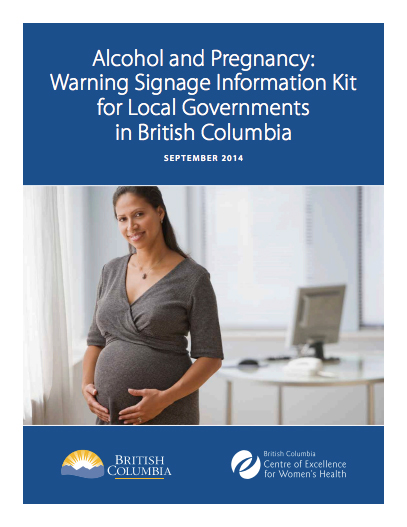Alcohol & Pregnancy: Warning Signage Information Kit Booklet
The government of BC has produced an information sheet and information kit on municipally mandated Alcohol and Pregnancy Warning Signage in alcohol retail outlets designed to help with understanding and learning about effective prevention messages and signage as part of a range of community-based initiatives to prevent fetal alcohol spectrum disorder.
“Alcohol warning signs are a universal prevention approach, which can be effective for transferring information about alcohol-related risks to specific population (Kalsher, Clarke & Wolgalter, 1993). A number of jurisdictions around the world use point-of-sale FASD warning and prevention signs to raise public awareness about the risks of drinking in pregnancy… In the province of Ontario, Sandy’s Law requires most establishments selling alcohol to post FASD warning signs, with the Alcohol and Gaming Commission of Ontario providing standardized warning signs for download from their website.”
 In British Columbia, the authority to “enact bylaws to protect health and serve other matters in the public interest under the Community Charter Act (2003)” lies with municipal governments. Over the last decade, several BC municipalities, including Nanaimo, Maple Ridge, Kelowna, Kamloops and Prince George, have passed bylaws requiring retailers to post point-of-sale FASD warning or prevention signs.
In British Columbia, the authority to “enact bylaws to protect health and serve other matters in the public interest under the Community Charter Act (2003)” lies with municipal governments. Over the last decade, several BC municipalities, including Nanaimo, Maple Ridge, Kelowna, Kamloops and Prince George, have passed bylaws requiring retailers to post point-of-sale FASD warning or prevention signs.
The Alcohol and Pregnancy Warning Signage information kit is designed “to provide city councils in BC with the rationale for point-of-purchase FASD warning and prevention sign bylaws, as well as details on the political requirements for enacting such bylaws under the public health component of the Community Charter Act.”
According to a Health Canada review of lessons learned from Canadian FASD messaging campaigns (2006), the potential uses include:
- Influencing knowledge and levels of awareness, changing attitudes and beliefs, and (with sufficient exposure) reducing risk behaviours.
- Encouraging information seeking.
- Conveying information about how to make positive change.
- Indicating where to receive support and services.
- Encouraging people who already know the facts.
The booklet gives a number of helpful pointers about effectiveness of signage in community settings that is useful both in this context, but also potentially for more general application for outreach programs to the community.
VISIBILITY
- Attention is enhanced when warning messages are larger in size, have easily readable text, are in colour, contain graphics or images, and when they rotate to introduce variation in content.
- Physical layout and placement: Messages containing vertical text, placed too low or too high, or are hidden from view, are less likely to attract attention.
- Placing signage close to the hazard makes it more likely that those who should see the message are exposed to it on at least a semi-regular basis.
COMPREHENSION
- Understanding improves when the message contains simple, clear and direct information.
- Readability and comprehension are enhanced when text is in both upper and lower case letters.
- Literacy, language and cultural barriers should be taken into account in message design.
RECALL
- Accurate recall relates directly to the experiences and perspective of the observer, with greater recall associated with messages of personal relevance. Research has shown women of childbearing ages were especially likely to recall warnings about birth defects.
- Recall also appears to be affected by the number and ordering of messages. Consumers may have limited ability to remember multiple messages, and earlier messages are more memorable than later ones.
POSITIVITY
- Warning signs with messaging designed to elicit guilt or shame are not generally effectivw.
The information kit also provides a Checklist and Guidelines with 10 items for use in FASD Warning and Prevention Sign development.
